Big Island Snorkeling Tours A Complete Guide
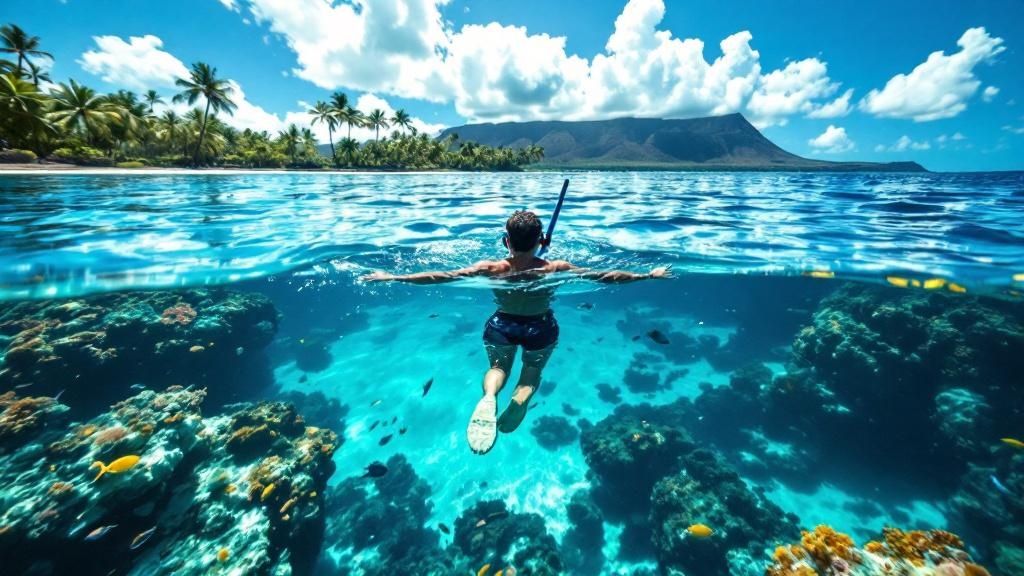
Welcome to the ultimate guide for Big Island snorkeling tours. If you're dreaming of gliding through crystal-clear water, surrounded by vibrant coral reefs and the kind of unique marine life that makes this a world-class destination, you're in the right place. These organized trips are your ticket to premier spots that are otherwise tough to reach, guaranteeing a safe and truly memorable adventure.
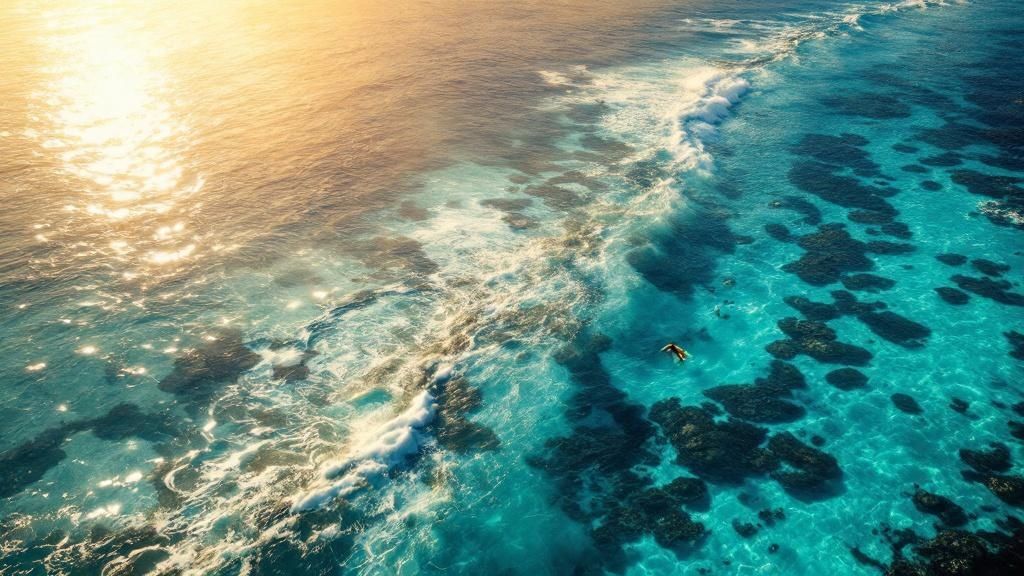
Why Big Island Snorkeling Tours Are Unforgettable
The Big Island isn't just another tropical paradise; it's a dynamic, living landscape where raw volcanic coastlines meet pristine marine sanctuaries. This dramatic contrast creates a snorkeling experience you just can't find anywhere else in Hawaii. The island itself is massive—literally twice the size of all other Hawaiian islands combined—and that scale translates to a staggering diversity of underwater worlds to explore.
So, what makes a guided tour the absolute best way to experience this aquatic wonderland? It all boils down to three things: access, safety, and local knowledge. So many of the most stunning snorkel spots are a real challenge to get to from shore. A tour boat, on the other hand, takes you right to the heart of these secluded coves and protected bays, and they usually come fully equipped with all the gear you'll need.
A guided tour completely removes the guesswork. Instead of stressing about where to go or whether the conditions are safe, you have a crew of experts whose only job is to give you the best, safest experience in the water.
This expert guidance is priceless. The crew knows precisely where to find the most colorful coral gardens and where specific animals, like playful spinner dolphins or majestic green sea turtles, are most likely to hang out. They handle all the logistics, so you can just kick back, relax, and soak in the incredible beauty all around you.
While your focus might be right here on the Big Island, for those thinking about exploring the wider Hawaiian islands, there are plenty of resources to help plan your next adventure.
The Magic Of Kealakekua Bay
If there's one iconic trip, it's the one to Kealakekua Bay. This historically significant Marine Life Conservation District on the Kona coast is the stuff of legends. The spot is famous for its incredibly protected, calm conditions and mind-blowing water clarity, where visibility often pushes past 100 feet.
The bay's unique geography acts as a natural shield from the trade winds, creating a serene, almost pool-like environment that’s perfect for snorkelers of any skill level. Because fishing is prohibited, the coral and fish populations have absolutely exploded, making for a dense, thriving ecosystem.
It’s no surprise that these popular half-day tours, which typically run from $80 to $120, often sell out weeks ahead of time. It's a real testament to the bay's world-class reputation.
What You Can Expect On A Tour
Most tours are set up to be all-inclusive, aiming for a completely hassle-free day of adventure. Here’s a quick rundown of what’s usually part of the deal:
- High-Quality Gear: You can expect to be provided with well-maintained masks, snorkels, fins, and flotation devices.
- Expert Guidance: A professional crew is always on hand to give safety briefings and help you out once you're in the water.
- Food and Refreshments: Many tours include snacks, lunch, and drinks to keep you energized throughout the day.
- Unrivaled Access: This is the big one. You'll get to visit top-tier snorkeling locations that are difficult, if not impossible, to reach on your own.
How to Choose Your Ideal Snorkeling Tour
Picking the right adventure from the sea of Big Island snorkeling tours can feel a bit overwhelming. With so many different boats, destinations, and once-in-a-lifetime experiences up for grabs, how do you find the one that’s just right for you? It really boils down to matching the tour with your personal sense of adventure, your comfort level, and who you're traveling with.
I like to think of it like picking a vehicle for a road trip. A big, stable catamaran is your comfortable RV—perfect for families or anyone who just wants to relax and have everything taken care of. Then you have the nimble Zodiac rafts, which are like off-road Jeeps, built to get you into rugged, hard-to-reach spots. Each one delivers a totally different kind of day.
Let's break down the main options to help you figure out what's best for your crew.
Catamarans: The Stable and Spacious Choice
There's a good reason large catamarans are the most popular choice out on the water. These wide, dual-hulled boats offer incredible stability, which makes them a fantastic pick for first-time snorkelers, families with kids, and anyone who gets a little queasy on the water. They are basically your floating home base for a day of fun.
Because they're so big, they come loaded with creature comforts you just won't find on smaller boats.
- Onboard Restrooms: A simple but absolutely crucial feature, especially on those longer half-day trips.
- Shaded Seating: Plenty of space to get a break from that intense Hawaiian sun.
- Food and Drinks: Most catamaran tours throw in snacks, a full lunch, and often an open bar, turning the trip into a complete, hassle-free experience.
- Easy Water Entry: They usually have stairs that lead right into the ocean or even a slide, making it a breeze for all ages and fitness levels to get in and out of the water.
These tours can handle larger groups, which often creates a fun, social vibe. While they can't dart into tiny sea caves, they promise a super smooth and relaxing ride to the island's best snorkeling destinations.
Zodiac Rafts: The Agile Adventurer
If you're someone who craves a bit more of a thrill, then a Zodiac-style raft is your ticket to an adrenaline-pumping day. These smaller, rigid-hulled inflatable boats are quick, incredibly maneuverable, and sit low to the water. This gives you a stunning, up-close-and-personal view of the coastline as you zip along.
The biggest advantage of a Zodiac is its ability to sneak into places the bigger boats just can't reach.
Captains can navigate into hidden sea caves, explore dramatic lava tubes, and get you closer to unique coastal features. This makes for a more intimate and dynamic tour that feels like a true expedition.
But all that agility comes with some trade-offs. The ride is definitely bumpier, and you'll find very few amenities on board—that often means no restroom and very little shade. These trips are perfect for adventurous singles, couples, and teenagers who are totally fine with a more rugged, fast-paced experience. If exploration and excitement are higher on your list than kicking back and relaxing, a Zodiac is an absolutely fantastic choice.
Unique Big Island Snorkeling Tours
Beyond the classic boat types, the Big Island is home to some truly unforgettable snorkeling adventures. The most famous is easily the manta ray night snorkel. This world-renowned tour takes you out after the sun goes down to witness gentle giants feeding on plankton drawn to underwater lights. It’s a surreal, almost magical experience that tops many travelers' bucket lists.
Another incredible option is a sail-and-snorkel trip. These tours blend the timeless, peaceful experience of sailing under wind power with stops at prime snorkeling spots. They tend to be more laid-back and focused on the journey itself, making them perfect for a romantic day out or for anyone just wanting a serene escape on the water. For a deeper dive into specific companies and packages, our guide to the best Big Island snorkel tours can help you compare your options.
Here's a look at the average underwater visibility at some of the island’s top snorkeling spots you can drive to, just to give you an idea of the amazing clarity you can expect in our waters.
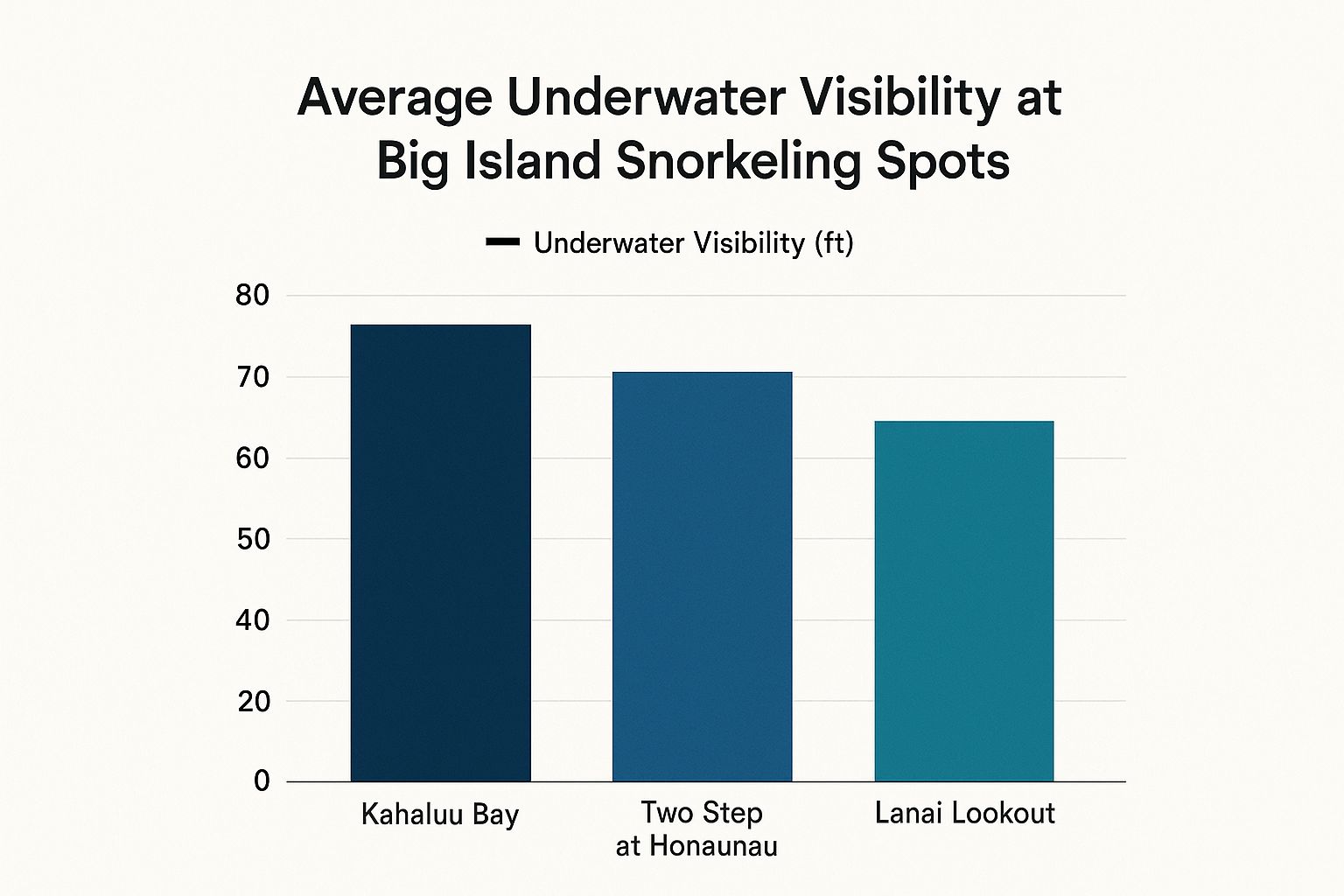
As you can see, while all three locations offer fantastic conditions, you’ll typically find that Kahalu'u Bay and Two Step have slightly better average visibility than what you'd find at Lanai Lookout.
Discover the Top Tour Destinations
Choosing one of the many Big Island snorkeling tours is like getting a key to a secret, underwater world. Sure, you can snorkel right from the beach, but the real magic—the stuff you see in documentaries—is often just a boat ride away. These aren't just pins on a map; they're living, breathing ecosystems, each with its own personality and cast of marine characters.
Let's take a look at the crown jewels of the Big Island's underwater realm, starting with the most famous of them all.
Kealakekua Bay and the Captain Cook Monument
Picture a place where Hawaiian history and vibrant nature crash together in the most spectacular way. That’s Kealakekua Bay. This spot is more than just a pretty place to snorkel; it's a designated Marine Life Conservation District. That’s a fancy way of saying its underwater residents are completely protected, and it shows. The result is an explosion of life and some of the clearest water you'll find anywhere in Hawaii—visibility often hits 100 feet or more.
The bay is hugged by towering lava cliffs that shield it from the open ocean, creating calm, sanctuary-like conditions. The moment you dip your face in the water, you're greeted by vast coral gardens buzzing with schools of impossibly bright yellow tangs, striped convict tangs, and colorful parrotfish munching on the reef. Onshore, the stark white Captain Cook Monument stands as a landmark, marking where the British explorer first made contact in 1779. Getting to this prime spot by land is a serious trek, which makes a boat tour the only practical way to soak in its full splendor.
A trip to Kealakekua Bay isn’t just about snorkeling. It’s a full immersion into a protected underwater wilderness that feels a world away from everything else. The sheer density of fish here is something you have to see to believe.
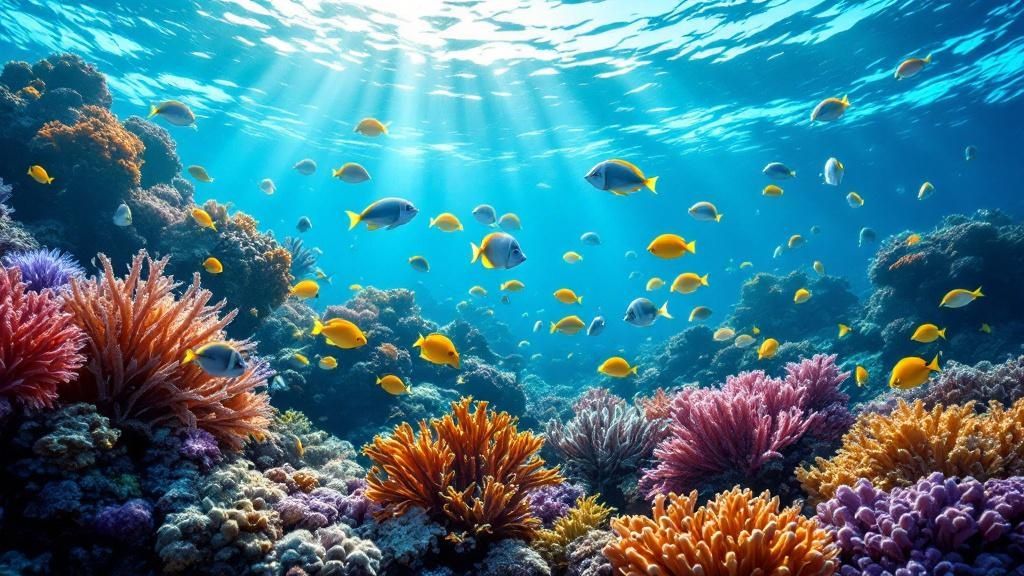
Puʻuhonua o Hōnaunau (The Famous Two Step)
Just a bit south of Kealakekua Bay is another local legend: Puʻuhonua o Hōnaunau, known to everyone as "Two Step." While you can get here from shore, arriving by boat gives you a totally different vantage point and lets you explore the deeper parts of the bay with zero hassle. It earned its nickname from the natural lava rock "steps" that make for a super easy entry into the water.
Two Step is an absolute haven for Hawaiian green sea turtles, or honu. It's not uncommon to see them gliding gracefully through the shallows or just chilling out on the ocean floor. The underwater landscape here is a fascinating maze of lava rock formations and healthy coral patches, drawing in a huge variety of reef fish. If you're there in the morning, you might even spot pods of spinner dolphins resting in the deeper parts of the bay—a truly unforgettable sight. Many Big Island snorkeling tours will package a stop here with other nearby spots.
The Pristine Kohala Coast
Cruising up the island's northwestern shore brings you to the Kohala Coast, which offers a completely different vibe. This sun-drenched coastline is famous for its luxury resorts, but its shores hide some of the most untouched and peaceful reefs on the island. Because they see fewer fins than the popular Kona spots, the coral here is exceptionally vibrant and healthy.
Tours that head to the Kohala Coast are usually on a mission to find secluded coves that promise a more private, intimate experience.
- Waialea Bay (Beach 69): A fantastic spot known for its calm, protected water in the mornings. You'll find a mix of sandy channels and intricate coral structures to explore.
- Secluded Coves: This is where the local knowledge of your tour operator really shines. They all have their own secret spots along this coastline, giving you a chance to see marine life without the crowds.
The sea life here is just as impressive, with chances to spot everything from moray eels peeking out of rocky crevices to the occasional majestic manta ray cruising on by. If you want to dive deeper into where to find these incredible creatures, you can explore our detailed guide on the top 15 best snorkeling spots on the Big Island. These destinations truly show why a guided tour is the ultimate key to unlocking the island's best-kept underwater secrets.
Snorkeling Without a Tour on the Big Island
While Big Island snorkeling tours are fantastic for hitting remote spots and having everything taken care of, there’s a special kind of magic in going it alone. For the DIY adventurer, snorkeling right from the shore is an incredible way to explore the underwater world on your own time.
It's a huge draw, especially if you're on a budget or just love the freedom of not being on a schedule. Picture it: you just grab your gear, walk down to a stunning cove, and slip into the warm Pacific whenever the mood strikes. That's the beauty of shore snorkeling. You set the pace and connect with the ocean on a deeply personal level.
Of course, that freedom means all the responsibility for gear and safety lands squarely on your shoulders. Unlike a guided tour with a captain and crew keeping watch, you have to be your own expert. You'll need to know how to read the ocean, keep an eye on currents and waves, and have a solid safety plan.
Top Shore Snorkeling Destinations
The Big Island is peppered with world-class snorkeling spots you can practically drive right up to. A couple of places, though, consistently stand out for their easy access and mind-blowing marine life. They are perfect for a self-guided day.
-
Hōnaunau Bay (Two Step): Famous for its almost-too-perfect entry from natural lava rock "steps," this spot is a snorkeler's dream. The bay is usually calm and crystal clear, with incredible views of coral gardens and a dizzying variety of reef fish. It’s also one of the best places to see Hawaiian green sea turtles (honu) gliding by.
-
Kahaluʻu Beach Park: This is the go-to spot for beginners and families, and for good reason. Kahaluʻu is a protected bay that's absolutely teeming with fish. The water is shallow and calm, and you'll find yourself surrounded by colorful schools almost the second you get in.
These free spots draw a ton of people every year, which just goes to show how amazing the island's shore access is. Places like Hōnaunau Bay—lovingly nicknamed Two Step—are famous for a reason. Besides turtles in the shallows, the deeper northern part of the bay is a resting area for spinner dolphins. Just remember, the rules are strict: it’s illegal to get closer than 45 meters to the dolphins to ensure they aren't disturbed.
Safety and Responsibility First
When you're out there on your own, you're the captain. The freedom is exhilarating, but it comes with a serious need for awareness and respect for the fragile marine world.
When snorkeling from shore, you are the captain of your own adventure. This means you must be diligent about checking weather forecasts, understanding local conditions, and never pushing beyond your comfort or skill level.
Always tell someone your plan—where you're going and when you expect to be back. And never, ever snorkel alone. It's also critical to use reef-safe sunscreen to protect the delicate corals you're there to see.
While exploring independently is hugely rewarding, some people find the expertise and safety net of a guided trip are well worth it. If you're curious about what a boat trip has to offer, check out our guide to Kona snorkeling by boat. Ultimately, whether you book a tour or go solo, snorkeling on the Big Island is an experience that will stick with you for a lifetime.
How to Prepare for Your Snorkeling Adventure
A fantastic day on one of the Big Island’s premier snorkeling tours starts long before you ever step onto the boat. Just like packing for a day hike, a little smart preparation is the secret to a totally stress-free experience. When you have the right gear and a clear plan, you can just relax and focus on the incredible underwater world waiting for you.
The real adventure begins at home. The day before your tour, take a quick minute to look over your booking confirmation. You're looking for key details like check-in time, the meeting spot, and any special instructions from your tour operator. Laying out a few essentials the night before also makes for a much smoother, less frantic morning.
What to Pack for a Perfect Day
While we and most other tour operators provide the core snorkeling gear, tossing a few personal items in a small bag will make your trip that much more comfortable. Trust me, forgetting something simple like a towel can put a real damper on an otherwise perfect day.
Here's a quick checklist of the must-haves:
- Reef-Safe Sunscreen: This is an absolute must. Standard sunscreens contain nasty chemicals like oxybenzone and octinoxate, which are incredibly damaging to Hawaii’s delicate coral reefs. Always grab a mineral-based sunscreen with zinc oxide or titanium dioxide to protect both your skin and the ocean.
- Towels and a Dry Change of Clothes: You’ll be so grateful for a warm, dry towel after your swim. And having a dry shirt or cover-up for the boat ride back to shore is one of those small comforts that makes a huge difference.
- Reusable Water Bottle: Staying hydrated under that Hawaiian sun is critical. Most tours offer water, but bringing your own bottle is a great way to make sure you have plenty—and it helps cut down on plastic waste.
- Waterproof Camera: You are definitely going to want to capture the memories of the vibrant fish and stunning coral gardens you’ll see on your big island snorkeling tours.
- A Hat and Sunglasses: Polarized sunglasses are a game-changer for cutting the glare on the water. A wide-brimmed hat will also provide some welcome shade on the boat.
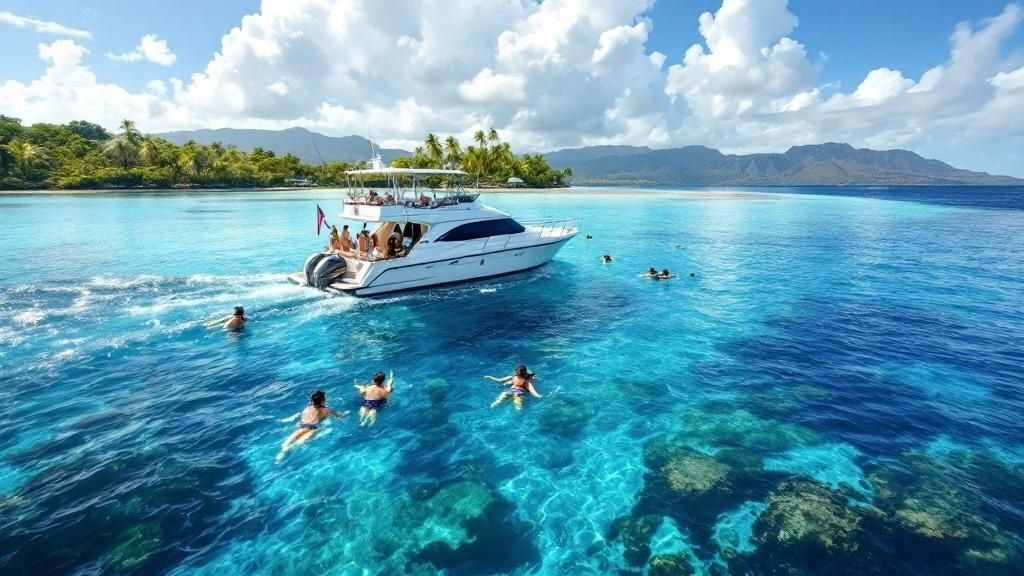
First-Timer Tips for a Great Experience
If this is your first time snorkeling, a few simple tricks can help you feel confident and comfortable in the water. The biggest hurdle for most beginners is just getting used to the gear and the feeling of breathing through a snorkel. It’s a little weird at first!
The most common issue is a leaky mask. To get that perfect seal, make sure any stray hair is pulled away from your forehead and cheeks. Then, place the mask on your face without the strap, breathe in gently through your nose, and let go. If the mask sticks to your face from the suction, you’ve got a good seal.
Breathing through a snorkel can feel pretty unnatural. The key is to take slow, deliberate breaths. Don't be afraid to practice in the shallow water near the boat until you feel relaxed. Panicking or breathing too quickly is what causes most problems.
Remember, the goal is to float effortlessly, not swim laps. Let your fins and the gentle current do the work. The less you splash and struggle, the more marine life you’ll see and the more energy you'll save. If you want more tips, you can find a ton of great info in our other articles on how to prepare for your Big Island snorkeling tours. A little reading will help you feel completely ready to make the most of every moment.
Common Questions About Snorkeling Tours
Diving into the world of Big Island snorkeling for the first time? You've probably got a few questions buzzing around. That's completely normal. Getting clear answers ahead of time means you can book your trip with confidence and just focus on the fun when the day arrives. Let's tackle some of the most common things travelers ask us.
One of the biggest worries is always the weather. What happens if the forecast looks a bit grim? Your safety is any good tour operator's number one priority. If the conditions get sketchy—think high winds, big swells, or pouring rain—the captain will make the call to cancel. You'll always be offered a full refund or a spot on another trip. Trust the captain on this one; they're reading the real-time ocean, not just a weather app on their phone.
Another question we hear all the time is about swimming skills. Do you need to be Michael Phelps to have a good time? Not at all.
While it helps to be comfortable in the water, you absolutely do not need to be a strong swimmer. Every professional tour provides flotation gear like pool noodles or life vests, letting you float effortlessly on the surface.
This gear takes all the work out of it, so you can just relax and be mesmerized by the fish below. Plus, the crew is always right there to help anyone who needs a hand.
What if I Have Never Snorkeled Before
First-timer? No problem at all. The best Big Island snorkeling tours are built for beginners. Before you even dip a toe in the ocean, the crew will give you a full rundown on everything. They’ll show you how to clear your mask if it fogs, the right way to breathe through the snorkel, and a few pro tips to make sure your first experience is amazing.
People also wonder if they need to lug their own snorkel gear all the way to Hawaii. Unless you have a special prescription mask or you're just really attached to your own fins, don't bother. Tour companies provide high-quality, sanitized masks, snorkels, and fins for everyone. It saves you a ton of hassle and suitcase space.
Finally, what about seasickness? It's a valid concern if you're someone who gets queasy. Opting for a larger, more stable boat like a catamaran can make a world of difference compared to a smaller raft. A great tip is to take a non-drowsy motion sickness pill about an hour before you head out. It's a simple step that can help you fully enjoy your day on the water. For even more answers, check out our guide covering the most frequently asked questions about Kona snorkel tours.
Ready for an unforgettable underwater adventure? Kona Snorkel Trips offers Hawaii's highest-rated and most-reviewed snorkeling experiences, from the magical Manta Ray Night Snorkel to explorations of historic Kealakekua Bay. Book your tour today!
